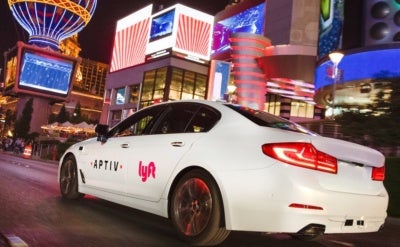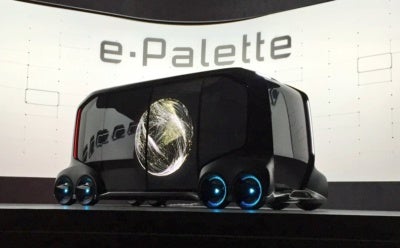In 2004, the Defense Advanced Research Projects Agency (DARPA) hosted its first Grand Challenge: a race to see which self-driving car could make it through 142 miles of the Mojave Desert fastest to earn a $1 million prize.
Fourteen years later, driverless cars have returned to the desert – this time, in Las Vegas. At the annual Consumer Electronics Show (better known as CES) held this week, more than a dozen driverless vehicles are on display. And with almost 300,000 square feet of exhibit space dedicated to autos this year, CES may feel more like a car show than an electronics show.
After years of testing, driverless cars have made significant progress towards commercial introduction. This week, some of the biggest names in transportation and technology announced their latest developments in the race to full autonomy.
 Those attending CES can hail a ride from one of Lyft’s free autonomous robo-taxis, though these cars aren’t technically driverless, as a safety driver and engineer are in the car.
Those attending CES can hail a ride from one of Lyft’s free autonomous robo-taxis, though these cars aren’t technically driverless, as a safety driver and engineer are in the car.
CES is the last stop on Mercedes’ “Intelligent World Drive,”– a five continent test drive of their autonomous S-Class sedan. Daimler’s tiny steering wheel-less and pedal-less Smart Vision EQ fortwo Concept is also on display at the show.
Ford, in collaboration with Domino’s, brought its autonomous pizza delivery car which is already up and running (in a limited fashion) in Michigan. Ford is partnering with Silicon Valley startup, Autonomic, on the Transportation Mobility Cloud to allow cars, bikes and mass transit to communicate. Ford also announced a new partnership with Postmates to look at how self-driving vehicles can deliver groceries, food and retail goods.

Toyota announced its new “e-Palette” – an electric, self-driving vehicle that would come in three different sizes with a customized interior depending on its use. Toyota is partnering with Uber, Uber’s Chinese rival Didi, Mazda, Pizza Hut, and Amazon to develop applications for the e-Palette in time for Tokyo’s 2020 Olympics.
Intel announced a partnership with Chinese auto giant SAIC Motors on the processors, sensors, and software algorithms the cars need to drive themselves. This partnership builds on agreements that Intel already has with Alphabet’s Waymo, BMW, Fiat-Chrysler, and Aptiv. Nvidia is working with Volkswagen to expand the use of AI to process sensor data inside and outside the car. Uber’s self-driving cars and trucks are also powered with Nvidia’s technology.
And the efforts toward autonomous travel are extending beyond driving. Bell Helicopter is developing a self-piloting air taxi. Bell will supply the technology to Uber for robotic flights and aiming to be operational in the 2020s.
The autonomous vehicle revolution is already transforming driving as we know it, and the potential for workforce disruption is obvious. The Boston Consulting Group projected that by 2030, one quarter of all miles driven in the U.S. could be through shared, self-driving vehicles. In 2016, there were more than 4 million jobs that involved driving trucks, buses, or taxis. Beyond these jobs, the Department of Commerce also identified 11.7 million other workers in occupations in which driving is an important task. The nature of these jobs – like personal-care aides, police officers, mail carriers, or real estate agents – could be transformed by self-driving cars.
Based on the news from CES this week, it’s clear that autonomous vehicle technology has the potential to fundamentally transform industries and jobs. U.S. Transportation Secretary Elaine Chao spoke at CES on the changing nature of transportation and the need for guidelines and regulations to keep pace. The Transportation Department will seek public comment on how to eliminate the hurdles which could stifle innovation, while encouraging safety. It will be critical for policymakers to not only address the regulatory framework around autonomous transportation, but also supports for drivers and workers whose jobs will be transformed – and may disappear – as this technology advances.

